Takeaways from “Technological Tools for Remote Monitoring of Protected Areas” Webinar
March 23, 2021
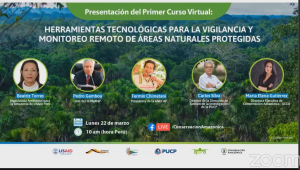 Our sister organization Conservación Amazónica – ACCA recently organized and hosted the webinar “Technological Tools for Remote Monitoring of Protected Areas” in Spanish, for members and technical specialists from the Amarakaeri Communal Reserve.
Our sister organization Conservación Amazónica – ACCA recently organized and hosted the webinar “Technological Tools for Remote Monitoring of Protected Areas” in Spanish, for members and technical specialists from the Amarakaeri Communal Reserve.
This event featured esteemed presenters like Pedro Gamboa, Director of Peru’s National Service of Natural and Protected Areas (SERNANP); Fermin Chimatani, President of indigenous organization ANECAP; and Carlos Silva Cárdenas, the Director of the Research Management at the La Pontificia Catholic University of Peru (PUCP). Additionally, Beatriz Torres, Environmental Specialist of the Amazon at USAID Peru, presented opening remarks while Conservación Amazónica – ACCA Executive Director Maria Elena Gutierrez gave closing remarks.
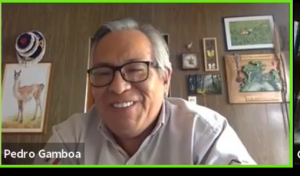 Pedro Gamboa of SERNANP highlighted the importance of protecting conservation areas during the pandemic, as these forests provide countless ecosystem services that benefit local communities. He also highlighted the importance of technology for rangers doing foot patrols, adding that, “We have been working for a long time with the National Program of Forest Conservation, and specifically the management of deforestation satellite imagery with Conservación Amazónica – ACCA.”
Pedro Gamboa of SERNANP highlighted the importance of protecting conservation areas during the pandemic, as these forests provide countless ecosystem services that benefit local communities. He also highlighted the importance of technology for rangers doing foot patrols, adding that, “We have been working for a long time with the National Program of Forest Conservation, and specifically the management of deforestation satellite imagery with Conservación Amazónica – ACCA.”
Patrols gather information on threats in local forests, and then action is taken by local governments. “By having a government policy of the use of this technology, we would be able to identify not only threats but also opportunities.” Additionally, Pedro referenced their work restoring ecosystems affected by illegal mining in the Tambopata National Reserve, where technology has been vital. Drone photographs show the affected area, which is later reviewed to determine the access points to each of these places. Indigenous communal reserves, such as the Amanakaeri, are part of the surveillance in a co-management system, where the communities are directly involved. “The area where illegal gold mining takes place increases everyday. Thus, it is important to have this co-management. We hope that we’ll be able to replicate it in the other nine Indigenous Communal Reserves, so we can protect all of them.” Pedro added his thanks to the “many actors who have allowed us to consolidate an effective management system where we can conserve nature that help local populations, that then in turn help us conserve these areas.”
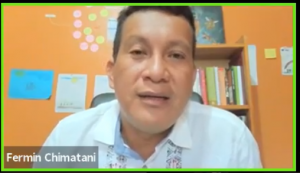 The next speaker was Fermin Chimatani, Fermin Chimatani, President of Peruvian indigenous organization ANECAP, the National Association of Contract Executors of the Administration. He highlighted their and SERNANP’s commitment to preserving forests saying, “We have been fulfilling this commitment [to protect the forests] hand-in-hand with the state…so that these communal reserves. as protected natural areas and ancestral territories, are at the service of local populations, indigenous communities, and the world, because of the importance of these spaces in terms of ecosystem services.”
The next speaker was Fermin Chimatani, Fermin Chimatani, President of Peruvian indigenous organization ANECAP, the National Association of Contract Executors of the Administration. He highlighted their and SERNANP’s commitment to preserving forests saying, “We have been fulfilling this commitment [to protect the forests] hand-in-hand with the state…so that these communal reserves. as protected natural areas and ancestral territories, are at the service of local populations, indigenous communities, and the world, because of the importance of these spaces in terms of ecosystem services.”
Fermin also talked about how Amazonian communities in Peru are collectively organized in their indigenous territories and lands, in traditional ways that include diverse forms of political, economic, administrative representation. “As is the case with communal reserves, the forests are in the hands of indigenous peoples,” he says. “The work within the national system of protected natural areas is effectively done with equal conditions as partners that help guide the implementation and conservation policies. Thus, policies not only relate to conservation, but also to intercultural development.” There are ten communal reserves that help manage five million hectares of forests, counting the adjoining landscapes, in alliance with SERNANP, but Fermin says is not easy to be confident in an alliance with the state fighting for a common goal. Everything has been key and building trust. We have an agreement and responsibilities, obligations, and rights.” One of the tasks is to promote forest monitoring in a voluntary way that reinforces this, implementing strategies assisted by allied organizations who support with technological tools and training. “The important thing is the empowerment of the youth, of the young leaders.”
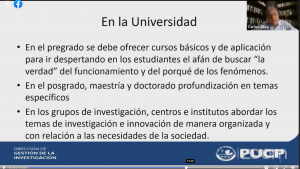 The final speaker was Carlos Silva Cárdenas, the Director of the Research Management at the La Pontificia Catholic University of Perú (PUCP), who spoke about the role of academia in technological innovation and protected areas. He began with an overview of how the pandemic has forced innovation as businesses and organizations try to advance during this unprecedented time. “The crisis caused by COVID 19 presents an opportunity that few feel prepared to take advantage of,” he said. “The implementation requirement differentiates innovation from other concepts, such as invention, because the innovation must be put into use or made available to others for their use.”
The final speaker was Carlos Silva Cárdenas, the Director of the Research Management at the La Pontificia Catholic University of Perú (PUCP), who spoke about the role of academia in technological innovation and protected areas. He began with an overview of how the pandemic has forced innovation as businesses and organizations try to advance during this unprecedented time. “The crisis caused by COVID 19 presents an opportunity that few feel prepared to take advantage of,” he said. “The implementation requirement differentiates innovation from other concepts, such as invention, because the innovation must be put into use or made available to others for their use.”
Carlos, who works in academia, emphasized how the first mission of a university is research and teaching. “Conditions must also be created so that startups or initiatives bring products to society, but always in a first stage, and then given autonomy.” Similarly, research groups, centers and institutes, should address research and innovation issues in an organized manner and in relation to the needs of society. He says, “Protected areas offer a good opportunity 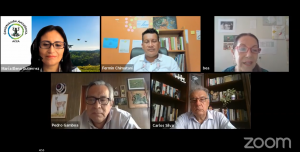 to facilitate the work of researchers through technology-based proposals that would accelerate the obtaining of and quality of results.”
to facilitate the work of researchers through technology-based proposals that would accelerate the obtaining of and quality of results.”
In conclusion, this webinar “Technological Tools for Remote Monitoring of Protected Areas”, was a well-rounded discussion that featured perspectives from various backgrounds. This event was organized by Conservación Amazónica – ACCA, qAIRa and the Pontificia Universidad Católica del Perú-PUCP, with the collaboration of World Resources Institute, Digital Democracy, International Institute of Social and HIV Studies, and USAID Peru’s valuable support.

